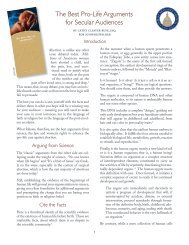The Effects of Divorce on Children - Family Research Council
The Effects of Divorce on Children - Family Research Council
The Effects of Divorce on Children - Family Research Council
Create successful ePaper yourself
Turn your PDF publications into a flip-book with our unique Google optimized e-Paper software.
additi<strong>on</strong> <str<strong>on</strong>g>of</str<strong>on</strong>g> a working mother, divorce leads to an above-average number <str<strong>on</strong>g>of</str<strong>on</strong>g><br />
sexual partners for the children <str<strong>on</strong>g>of</str<strong>on</strong>g> divorce as adults. 123<br />
Following a divorce, most mothers have to work full-time. This combinati<strong>on</strong> <str<strong>on</strong>g>of</str<strong>on</strong>g><br />
divorce and a full-time working mother leads to the highest level <str<strong>on</strong>g>of</str<strong>on</strong>g> teenage<br />
sexual activity 124 and is significantly correlated with multiple sexual partners in<br />
adult life. 125<br />
Percent <str<strong>on</strong>g>of</str<strong>on</strong>g> Girls Who Have Ever Had<br />
an Unwed Pregnancy<br />
60%<br />
50%<br />
40%<br />
30%<br />
20%<br />
10%<br />
"Ever Had an Unwed Pregnancy" by Structure <str<strong>on</strong>g>of</str<strong>on</strong>g> <strong>Family</strong> <str<strong>on</strong>g>of</str<strong>on</strong>g> Origin<br />
19%<br />
Married<br />
Always Intact<br />
36%<br />
Married<br />
Stepfamily<br />
26%<br />
Intact<br />
Cohabiting<br />
<strong>Family</strong><br />
37% 36%<br />
Cohabiting<br />
Stepfamily<br />
Structure <str<strong>on</strong>g>of</str<strong>on</strong>g> <strong>Family</strong> <str<strong>on</strong>g>of</str<strong>on</strong>g> Origin<br />
Scott Talkingt<strong>on</strong>, Ph.D.<br />
Source: Nati<strong>on</strong>al L<strong>on</strong>gitudinal Survey <str<strong>on</strong>g>of</str<strong>on</strong>g> Youth (1997)<br />
Single<br />
<str<strong>on</strong>g>Divorce</str<strong>on</strong>g>d<br />
Parent<br />
54%<br />
Always<br />
Single<br />
Parent<br />
Pregnancy. Women whose parents separated during childhood are more likely<br />
to have an out-<str<strong>on</strong>g>of</str<strong>on</strong>g>-wedlock teenage pregnancy, 126 and men with divorced or<br />
separated parents are more likely to father a child with a teenage mother. 127 In<br />
123 Robert J. Quinlan, “Father Absence, Parental Care, and Female Reproductive Development,”<br />
Evoluti<strong>on</strong> and Human Behavior 24 (2003): 376–390.<br />
124 John O. G. Billy (1994). As cited in David Lars<strong>on</strong>, <str<strong>on</strong>g>The</str<strong>on</strong>g> Costly C<strong>on</strong>sequences <str<strong>on</strong>g>of</str<strong>on</strong>g> <str<strong>on</strong>g>Divorce</str<strong>on</strong>g><br />
(Rockville, MD: Nati<strong>on</strong>al Institute for Healthcare <strong>Research</strong>, 1995), 131.<br />
125 Seidman, Mosher, and Aral (1994). As cited in David Lars<strong>on</strong>, <str<strong>on</strong>g>The</str<strong>on</strong>g> Costly C<strong>on</strong>sequences <str<strong>on</strong>g>of</str<strong>on</strong>g><br />
<str<strong>on</strong>g>Divorce</str<strong>on</strong>g> (Rockville, MD: Nati<strong>on</strong>al Institute for Healthcare <strong>Research</strong>, 1995), 131.<br />
126 Robert J. Quinlan, “Father Absence, Parental Care, and Female Reproductive Development,”<br />
Evoluti<strong>on</strong> and Human Behavior 24 (2003): 376–390.<br />
Kathleen E. Kiernan and John Hobcraft, “Parental <str<strong>on</strong>g>Divorce</str<strong>on</strong>g> during Childhood: Age at First<br />
Intercourse, Partnership and Parenthood,” Populati<strong>on</strong> Studies 51 (1997): 41-55.<br />
Frank F. Furstenberg, Jr. and Julien O. Teitler, “Rec<strong>on</strong>sidering the <str<strong>on</strong>g>Effects</str<strong>on</strong>g> <str<strong>on</strong>g>of</str<strong>on</strong>g> Marital<br />
Disrupti<strong>on</strong>: What Happens to <strong>Children</strong> <str<strong>on</strong>g>of</str<strong>on</strong>g> <str<strong>on</strong>g>Divorce</str<strong>on</strong>g> in Early Adulthood?” Journal <str<strong>on</strong>g>of</str<strong>on</strong>g> <strong>Family</strong><br />
Issues 15 (1994): 173-190.<br />
Sara McLanahan and Larry Bumpass, “Intergenerati<strong>on</strong>al C<strong>on</strong>sequences <str<strong>on</strong>g>of</str<strong>on</strong>g> <strong>Family</strong> Disrupti<strong>on</strong>,”<br />
American Journal <str<strong>on</strong>g>of</str<strong>on</strong>g> Sociology 94 (1988): 130-152.<br />
127 Robert F. Anda, Daniel P. Chapman, Vincent J. Felitti, Valerie Edwards, David F.<br />
Williams<strong>on</strong>, Janet B. Cr<str<strong>on</strong>g>of</str<strong>on</strong>g>t, and Wayne H. Giles, “Adverse Childhood Experiences and Risk <str<strong>on</strong>g>of</str<strong>on</strong>g><br />
Paternity in Teen Pregnancy,” Obstetrics and Gynecology 100 (2002): 37-45.<br />
19




